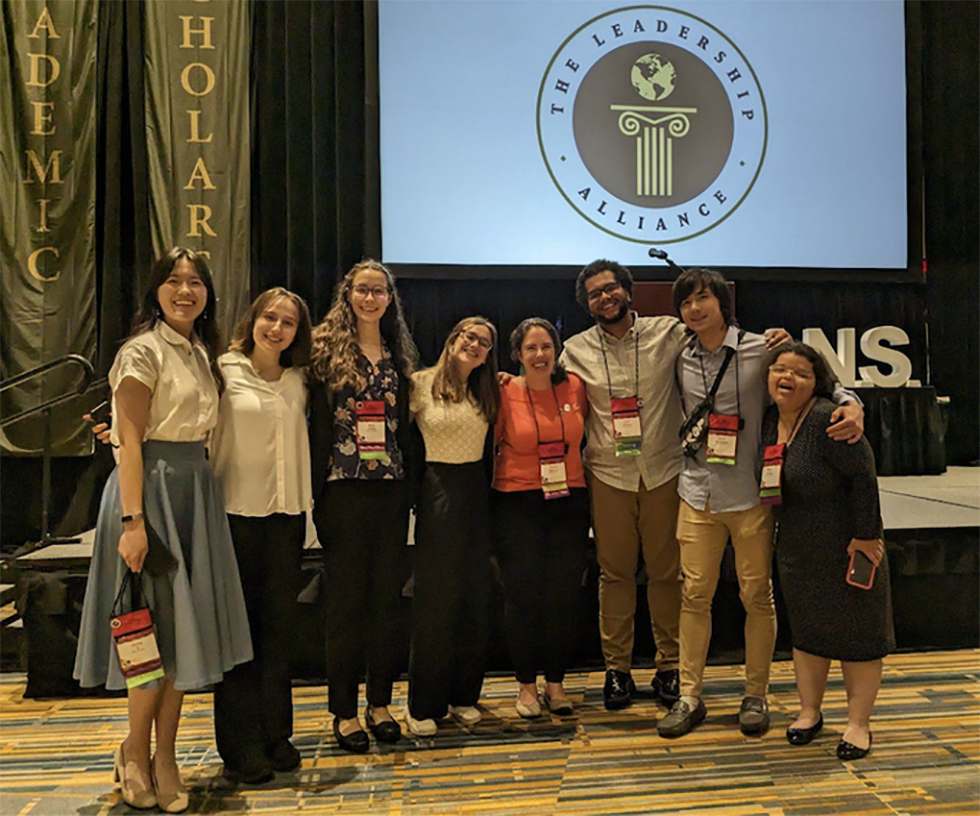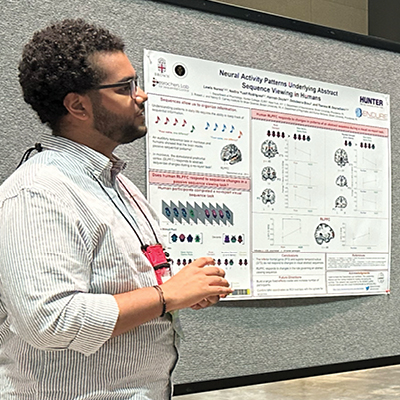
In nine short weeks, these scholars all joined a different Carney-affiliated lab, worked closely with a graduate student or postdoctoral mentor, participated in a rigorous introductory computational neuroscience workshop, attended weekly professional development sessions run by Carney’s world-class faculty and received coaching around pursuing a graduate degree. They also went to the beach, toured Newport and sampled pretty much every delicacy Thayer Street has to offer.
This summer, eight undergraduates from across the country journeyed to Brown to study computational brain science and explore what possibilities each of their futures hold. In nine short weeks, these scholars all joined a different Carney-affiliated lab, worked closely with a graduate student or postdoctoral mentor, participated in a rigorous introductory computational neuroscience workshop, attended weekly professional development sessions run by Carney’s world-class faculty and received coaching around pursuing a graduate degree. They also went to the beach, toured Newport and sampled pretty much every delicacy Thayer Street has to offer.
The Carney Summer Scholars program was established in 2020 in partnership with The Leadership Alliance, an organization with more than 35 partner institutions across the country that is working to address the shortage of individuals from historically underrepresented groups in doctoral training programs, academia and the broader research workforce. As a leader in computational brain science, Carney contributes to this effort by training undergraduates from schools without computational courses in skills and research techniques that–with the advent of larger and larger datasets–are fast becoming integral for brain science of all kinds.
“Learning computational modeling has been a highlight of my time here, because my school doesn’t really have any of that. It’s really small and there’s one cognitive neuroscientist. So it’s been super valuable to be able to go to a formal workshop, have lectures about it and also spend my summer actually doing it,” said Ainsley Bonin, a Colby College student who used machine learning to study cognitive control in the Shenhav Lab, and is going to continue working remotely on the project as she completes her senior year.
“My mind was blown,” said Bryanna Vilnaigre, an NYU undergraduate in the Oh Lab who worked with PET and fMRI data to investigate differences across participants exhibiting varying stages of Alzheimer’s. She plans to combine her new computational skills with her background in molecular biology.
“Coming into this, I wasn’t familiar at all with machine learning and that was essentially my entire project,” added Rachel Kaniuk, a cognitive science and math double major from Rutgers University who hadn’t yet had the opportunity to bridge these two disciplines. The project she worked on in the Laboratory for Cognitive and Perceptual Learning explored the different difficulty factors humans and A.I. encounter when faced with the same learning tasks.
Other students were struck by the level of access they got to mentors and faculty, noting how this helped them to envision future careers.
“There’s a ton of research going on, but you can still walk up to P.I.s and postdocs and ask them almost anything,” said C.J. Abeshaus, a Scripps College student in the Jones Lab, who also majors in dance and is interested in movement’s relationship to the brain.

The Leadership Alliance National Symposium.
“Being able to work with faculty and being around Carney definitely helped me in the decision of applying here in the future,” said Lewis Nunez, a Hunter College student. The experience of working with data from human fMRI imaging in the Desrochers Lab helped refocus his thoughts around graduate education.
The cherry on top of the students’ Carney Summer Scholars experience was the opportunity for the cohort to travel together to the annual Leadership Alliance National Symposium, an event that draws roughly 400 student participants. At the conference, held this year at the Connecticut Convention Center in Hartford, CT, each student presented a poster on their original research. The experience highlighted realities graduate students encounter and must surmount. When the project Sylvia E was working on in the Brown Language and Thought Lab didn’t get any research participants in time, she jumped to another one, managing to complete her analysis and poster in a single week. “It was intense,” she said, “but I learned a lot.”
Moreover, what E, a philosophy and cognitive science major from the University of Illinois Urbana-Champaign, learned about how computational neuroscience can be applied to the study of language has radically changed her career trajectory.
“It was super interesting to me to see how all these theories about syntax and semantics actually came to life through the experiments we did. I didn’t realize using computers to study humans and language was something you could do. I was initially considering law school because I was very worried about my job prospects, but I really like this. I’ve decided I should just go to grad school because I’d actually be happy and I’d really enjoy what I study.”
Another student, Mary Avella, is excited to take her research comparing learning styles between autistic and neurotypical populations in the Learning, Memory and Decision Lab as far as she possibly can. As one of four students who came to Carney Summer Scholars through a BP-ENDURE program, in November she will present an updated version of her poster at the annual meeting of the Society for Neuroscience, an international conference that regularly attracts 30,000 attendees and will be held this year in Washington, D.C. A Hunter College student who only recently declared a neuroscience major, Avella identifies as autistic and as a woman with a facial difference. Her project gave her the opportunity to investigate the neural underpinnings of her lived experience.
“I learned a lot about myself this summer. Everything happened all at once,” Avella said. “This is my first research experience ever. This is my first time away from home. This is my first real job where I’m getting paid. And this is my first research project.”

The Leadership Alliance National Symposium.
“It’s amazing how fast the nine-week program flies by,” said program director Kristin Webster, the assistant director of training and development at the Carney Institute. “I’m always impressed with how much research scholars are able to accomplish in such a short time, and how the whole brain science community — graduate students, postdocs and faculty — enthusiastically engage with the Carney Summer Scholars. Our summer students walk away with a unique appreciation for what a supportive training community we have at Brown.”
The Carney Summer Scholars call for applications will open November 1 and close on February 1.
The 2023 Carney Summer Scholars program ran from June 5 to August 4 this year, culminating in a one-of-a-kind experience where undergraduate scholars presented posters on their original research at the Leadership Alliance National Symposium in Hartford, CT.